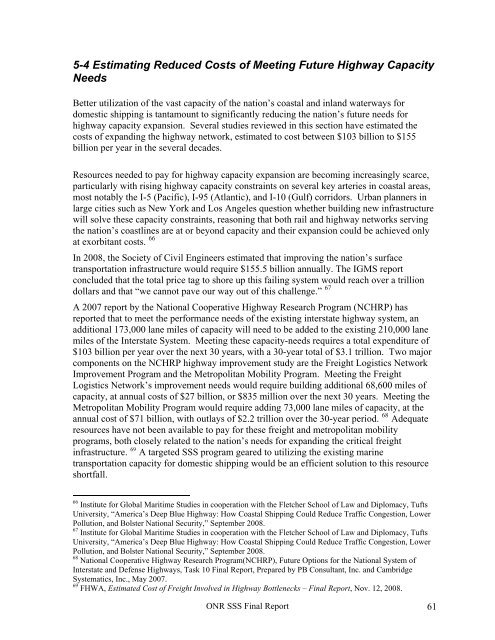Office of Naval Research - National Transportation Library
Office of Naval Research - National Transportation Library
Office of Naval Research - National Transportation Library
You also want an ePaper? Increase the reach of your titles
YUMPU automatically turns print PDFs into web optimized ePapers that Google loves.
5-4 Estimating Reduced Costs <strong>of</strong> Meeting Future Highway CapacityNeedsBetter utilization <strong>of</strong> the vast capacity <strong>of</strong> the nation’s coastal and inland waterways fordomestic shipping is tantamount to significantly reducing the nation’s future needs forhighway capacity expansion. Several studies reviewed in this section have estimated thecosts <strong>of</strong> expanding the highway network, estimated to cost between $103 billion to $155billion per year in the several decades.Resources needed to pay for highway capacity expansion are becoming increasingly scarce,particularly with rising highway capacity constraints on several key arteries in coastal areas,most notably the I-5 (Pacific), I-95 (Atlantic), and I-10 (Gulf) corridors. Urban planners inlarge cities such as New York and Los Angeles question whether building new infrastructurewill solve these capacity constraints, reasoning that both rail and highway networks servingthe nation’s coastlines are at or beyond capacity and their expansion could be achieved onlyat exorbitant costs. 66In 2008, the Society <strong>of</strong> Civil Engineers estimated that improving the nation’s surfacetransportation infrastructure would require $155.5 billion annually. The IGMS reportconcluded that the total price tag to shore up this failing system would reach over a trilliondollars and that “we cannot pave our way out <strong>of</strong> this challenge.” 67A 2007 report by the <strong>National</strong> Cooperative Highway <strong>Research</strong> Program (NCHRP) hasreported that to meet the performance needs <strong>of</strong> the existing interstate highway system, anadditional 173,000 lane miles <strong>of</strong> capacity will need to be added to the existing 210,000 lanemiles <strong>of</strong> the Interstate System. Meeting these capacity-needs requires a total expenditure <strong>of</strong>$103 billion per year over the next 30 years, with a 30-year total <strong>of</strong> $3.1 trillion. Two majorcomponents on the NCHRP highway improvement study are the Freight Logistics NetworkImprovement Program and the Metropolitan Mobility Program. Meeting the FreightLogistics Network’s improvement needs would require building additional 68,600 miles <strong>of</strong>capacity, at annual costs <strong>of</strong> $27 billion, or $835 million over the next 30 years. Meeting theMetropolitan Mobility Program would require adding 73,000 lane miles <strong>of</strong> capacity, at theannual cost <strong>of</strong> $71 billion, with outlays <strong>of</strong> $2.2 trillion over the 30-year period. 68 Adequateresources have not been available to pay for these freight and metropolitan mobilityprograms, both closely related to the nation’s needs for expanding the critical freightinfrastructure. 69 A targeted SSS program geared to utilizing the existing marinetransportation capacity for domestic shipping would be an efficient solution to this resourceshortfall.66 Institute for Global Maritime Studies in cooperation with the Fletcher School <strong>of</strong> Law and Diplomacy, TuftsUniversity, “America’s Deep Blue Highway: How Coastal Shipping Could Reduce Traffic Congestion, LowerPollution, and Bolster <strong>National</strong> Security,” September 2008.67 Institute for Global Maritime Studies in cooperation with the Fletcher School <strong>of</strong> Law and Diplomacy, TuftsUniversity, “America’s Deep Blue Highway: How Coastal Shipping Could Reduce Traffic Congestion, LowerPollution, and Bolster <strong>National</strong> Security,” September 2008.68 <strong>National</strong> Cooperative Highway <strong>Research</strong> Program(NCHRP), Future Options for the <strong>National</strong> System <strong>of</strong>Interstate and Defense Highways, Task 10 Final Report, Prepared by PB Consultant, Inc. and CambridgeSystematics, Inc., May 2007.69 FHWA, Estimated Cost <strong>of</strong> Freight Involved in Highway Bottlenecks – Final Report, Nov. 12, 2008.ONR SSS Final Report 61
















